#mola tecta
Photo

Mola mola. The mola we all knowla. The mola we all molove. What an incredible creature, Mola mola is! Such a strange shape, so many eggs, no swim bladder... and the size. Its most prized aspect! If you know one thing about Mola mola, it’s that it is the largest bony fish, right?
...Right?
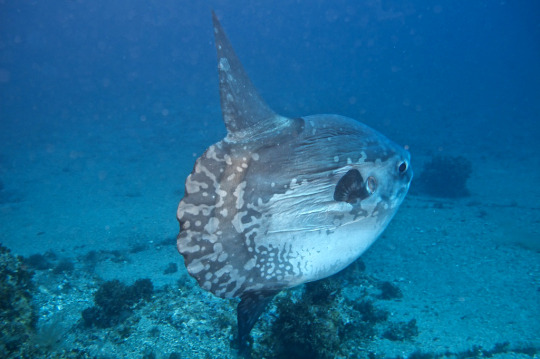
Nuh-uh-uh, Mola mola. Don’t try and sneak away. It’s very noticeable. After all, you are one of the biggest bony fish!
Let me repeat that. One of the biggest bony fish.
Mola mola, the ocean sunfish, is NOT in fact the largest known bony fish! You’d think we were talking about Mola tecta, because this sunfish has hoodwinked us!
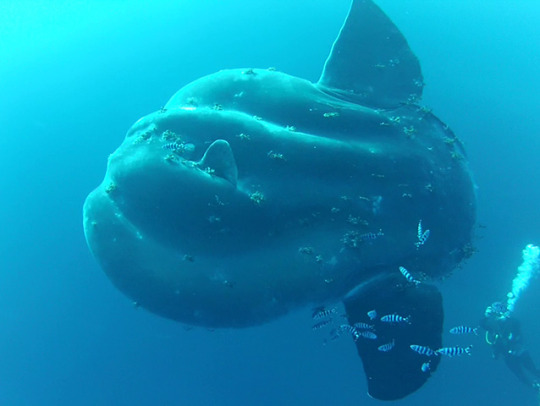
Behold MOLA ALEXANDRINI! Known, very appropriately, as the giant sunfish. This is the true heaviest bony fish! Not Mola mola, as has so been thought, and as I have even claimed in front of all of you. I was wrong! Mola alexandrini has been recorded weighing up to 6,049 pounds, with Mola mola trailing in the measly little 2,000s range. But if Mola alexandrini can be so much bigger, how was Mola mola seen as the champion for so long?

It was a misunderstanding. A misidentification! That huge specimen was caught all the way back in 1996, but thought to be Mola mola until it was reevaluated in 2017! Members of the Mola genus are just always accidentally tricking us humans. I’m sure they would say “sooorry” in a deep and booming, yet slow and gentle voice if they knew.
So how can you #KnowYourMolas? It is easy to confuse them- even scientists do it- but generally, be sure to notice the shapes of both the face and the clavus (the funny butt fin)! If the face is relatively smooth, and especially if the clavus has a scalloped shape, that’s Mola mola. If the face is bulgy and bumpy and the clavus is smooth and round, that’s Mola alexandrini! And if the face is smooth but the clavus is too, then you have been hoodwinked by Mola tecta!
So there you have it. The truth about the Mola mola! Not the biggest after all... but that does not matter to me. Mola mola will always be my favorite! That being said, please show Mola alexandrini some love too, as despite its size, it is still a lesser known Mola!
And who knows? Maybe even alexandrini will be dethroned! Maybe we will find a bigger alexandrini, or maybe a bigger mola! Maybe even a different species altogether is the true largest bony fish! There is no way to know what the future has in store... so many secrets in the ocean!
Refer here for more information on the updated identification!
#mola mola#mola alexandrini#mola tecta#molidae#mola#ocean sunfish#giant sunfish#hoodwinker sunfish#april fools#not mario#fish#mod chikako
2K notes
·
View notes
Text
Wet Beast Wednesday: ocean sunfish
Everybody knows ocean sunfish, right? Those giant, slow, silly-looking, parasite-ridden morons that eat jellyfish and can't defend themselves from predators really are the worst fish right?

(GIF: Lex Luthor screaming "WRONG!" from the movie Superman Returns)
First of all there's no such thing as a "best" or "worst" animal and judging animals by human standards of what is cool or successful is silly because our standards are not even universal among humans, let along other species. Secondly, the closest thing we have to a way to judge a species is how successful it is in its niche and sunfish are doing pretty good, thank you very much. Today I'll be talking about sunfish and how they are not bad fish at all.
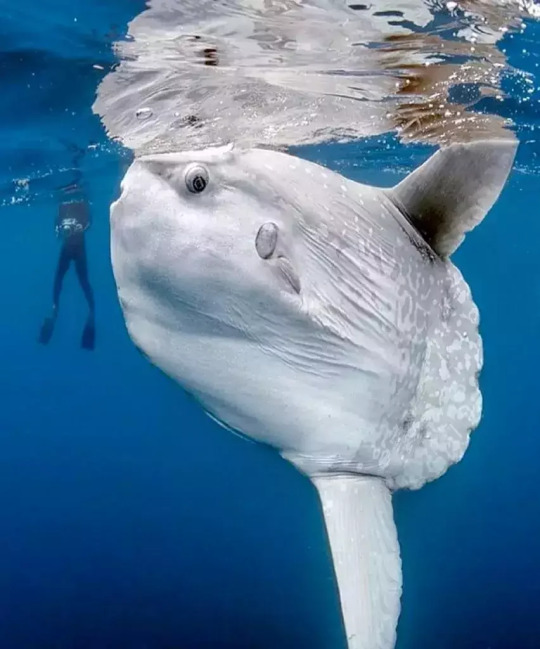
(Image: a Mola mola located near the surface of the ocean, with the tip of its dorsal fin and part of its head breaching the surface. It is a round fish with no tail, only a wrinkly region of its body. Its dorsal and anal fins are long and slender The eyes and mouth are proportionately small. It is a pale white with light grey spots. A SCUBA diver is visible in the background. End ID)
Ocean sunfish, or molas, are members of the family Molidae, which is divided into five known species across three genuses. Im mostly going to be talking about members of the genus Mola, but I'll mention the other two as well. Molas are known for their size and odd appearances, looking like someone chopped a fish in half and the front half went swimming off on its own. They are members of the order Tetraodontiformes, making them cousins to pufferfish, triggerfish, boxfish, and others. While many members of that order are known to be highly poisonous, molas are not. They also lack several other common traits. Despite being bony fish, most of the mola skeleton is made of cartilage and they do not have swim bladders, forcing them to actively swim to maintain their position in the water column. Instead of a tail and caudal fin, sunfish have a structure called the clavus. The clavus is formed mostly from connective tissue and is used as a rudder. Because the clavus is mostly made of connective tissue, damage to it is not particularly harmful to the fish. There have been molas found alive and well that have had portions of their clavus eaten by predators. Because of their shortened stature, molas have the fewest vertebrae of all fish. The dorsal and anal fins are elongated and are used to provide propulsion by flapping back and fourth similarly to how birds wings move, albeit slower. Minute alterations in the angle each fin moves through the water help with steering, while more sharp turns are aided with jets of water ejected through the mouth and gills. Like their other Tetraodintid relatives, mola teeth are fused together into a beak-like structure that prevents them from closing their mouths. They also have some more regular pharyngeal teeth in the backs of their mouths. Some reports say that the fish can make noises by grinding the pharyngeal teeth together. Mola skin is thick and rough, described as being similar to sandpaper in texture. Like most fish, the skin is covered in a layer of protective mucus.

(Image: a mola sunbathing. It is positioned with one side of its body facing the surface. Its body is just under the water's surface. End ID)
The three species in the genus Mola are Mola mola, the ocean sunfish and most well-known of the molas, Mola alexandrini, the giant, southern, or bumphead mola, and Mola tecta, the hoodwinker sunfish. Mola mola has an average weight of 247 to 1000 kg (545 to 2205 lbs), mouth to clavus length of 1.8 m (5.9 ft) and dorsal to anal fin length of 2.5 m (8.2 ft), though some individuals can get much large. The largest individual on record had a length of 3.3 m (10.8 ft), height of 3.2 m (10.5 ft) and weighed 2300 kg (5100 lbs). M. alexandrini is the largest of the species. The largest known southern sunfish measured in at 2744 kg (6049 lbs) and 3.25 m (10.66 ft) from mouth to clavus, making it the largest known bony fish in the world. They can be distinguished from M. mola by the presence of bumps on the forehead and chin, a more rounded clavus, and differently-shaped scales. M. tecta is known as the hoodwinker sunfish because it was long mistaken for one of the other two species and was only identified as a separate species in 2015 after the body of one washed up in Christchurch, Aotearoa/New Zealand and was examined by scientists. Because it has only recently been discovered, little is known about this species. They appear to have the same range of sizes and weights of the other two species and can be distinguished by a slimmer body shape and a smooth clavus. All three species are found in tropical and temperate waters worldwide, though M. alexandrini and M. tecta are more commonly found in the southern hemisphere.
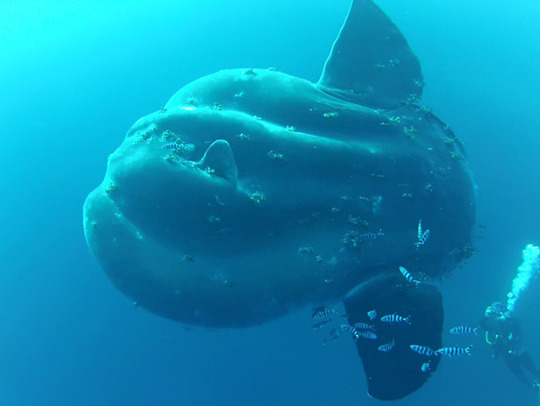
(Image: a Mola alexandrini underwater. It is distinguishable from Mola mola by the two bumps above and below its facial region, making it look lumpy. It is surrounded by striped cleaner fish. A SCUBA diver is in the background. End ID)
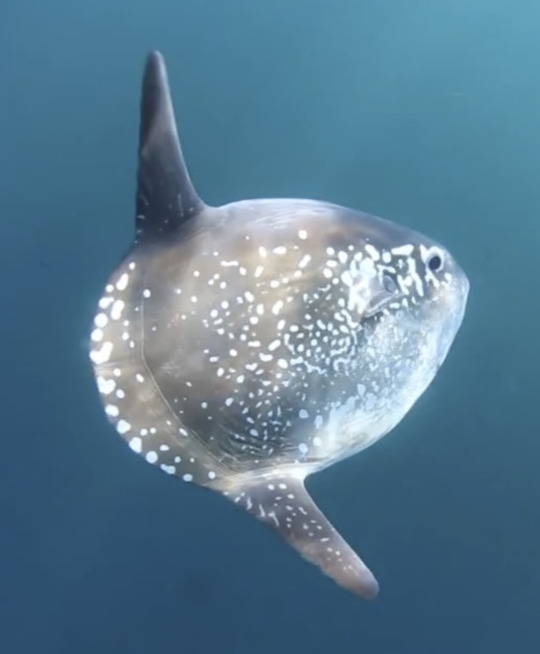
(Image: a Mola tecta seen from the side. It is smoother than the other two species. More of its body is grey with white spots. End ID)
Molas are open-ocean dwellers that live life in the slow lane. For a long time, it was believed they were moved around by ocean currents they could not swim against, making them plankton. We now know they not only can swim against the current, they are capable of bursts of speed fast enough to breach the water's surface and briefly go airborne. Sunfish are named for their habit of basking at the surface of the water. It was formerly believed they spent most of their time at the surface, but thanks to tagging, we know they make frequent dives into the deep ocean. They likely bask at the surface to warm up between dives. You may not expect something as slow as a sunfish to be a predator, but they are. Much of their diet consists of gelatinous animals including jellyfish, siphonophores, ctenophores, and salps, though they will also eat small fish, fish larvae, squids, crustaceans, and even seagrass. Because they can't chew, sunfish move prey into and out of their mouth by rapidly switching between sucking water in and spitting it out in order to shred the prey into pieces small enough to swallow. Special mucus lining the digestive system may protect the molas from the stinging tentacles of their prey. Molas and other jellyfish-eaters like the leatherback sea turtle play an important role in the ecosystem by keeping jellyfish populations down. Jellyfish are not particularly nutritious, so the sunfish need to eat a lot of them to survive, something they seem to be pretty good at. Being slow and having a very low-energy lifestyle helps the fish survive on a less-nutritious diet, making them very energy efficient. One thing molas get a lot of flack for online is having lots of parasites (with up to 40 known species). This doesn't really make sense. Every species has parasites. An animal in the wild that doesn't have parasites is vanishingly rare. Having parasites doesn't make an animal suck, it makes them ordinary. Because of their parasite load, molas are frequent visitors to cleaner fish, who will eat their parasites. Molas will also let seabirds land on them and eat their parasites while they rest on the surface. The molas attract birds by splashing at the surface. Adult molas have few natural predators, but are hunted by sharks, sea lions, and orcas. Interestingly, sea lions have been known to kill molas apparently for sport, ripping off the fins and then leaving the mola to die.

(Image: a mola seen from the front. Multiple smaller fish are picking parasites off of its skin. End ID)
Molas are broadcast spawners who release their gametes into the water alongside each other. A female mola can release 300 million eggs at a time, more than any other vertebrate. Newly hatched sunfish are 2.5 millimeters long and are often cited as having the largest discrepancy in size between juvenile and adult of any vertebrate. An adult mola can be 60 millions times the weight of a larva. The larvae look very different than adult, lacking their dorsal and anal fins but having pufferfish-like spines. Juveniles school together for protection and become solitary as they age. The diet of the fish varies as they age, with younger fish feeding more on squid, worms, crustaceans, and fish but becoming more reliant on jellyfish and other gelatinous prey as they age. We don't know the growth rate of molas, but a juvenile in the Monterey Bay Aquarium grew from 26 to 339 kg (57 to 880 lbs) in 15 months, suggesting they grow rapidly. The maximum age of molas is unknown, though individuals in captivity have lives for up to 10 years.

(Image: a mola larva. It is a brown ball with large, black eyes and no visible fins. It is covered in transparent, conical spines. End ID)
The two non-Mola sunfish are Ranzania laevis, the slender sunfish and Masturus lanceolatus, the sharptail sunfish. Both are alone in the genuses, but other species are suspected. I also found references to other species in Masturus, but could find literally no information about them other than that Masturus oxyuropterus is listed in some records. The sharptail sunfish looks very similar to Mola mola and reaches similar sizes, but its clavus has an extension that looks like a short tail. They were initially believed to be deformed molas before being recognized as a separate species. Unlike molas, sharptail sunfish are rarely seen at the surface, preferring to stay in deeper water. The slender sunfish is the smallest of the family, reaching up to a meter long. While we don't know much about them, we know their diet includes a lot of fast-moving squid, indicating they can move faster than their much larger relatives.
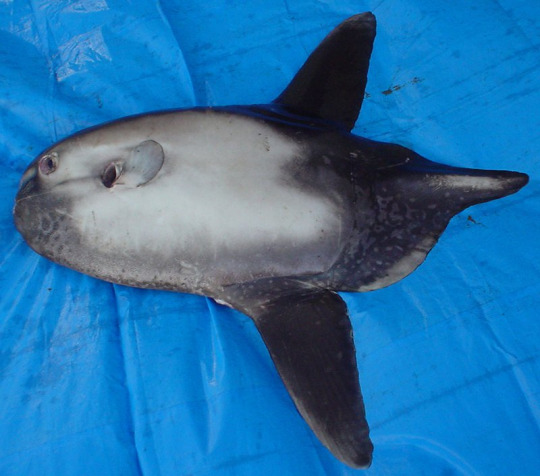
(Image: a sharptail sunfish lying on a blue tarp. It looks similar to a Mola mola , but with black clavus and fins. At the back of the clavus is a triangular extension. End ID)
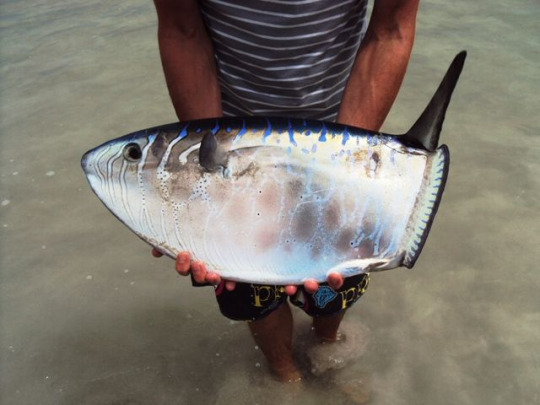
(Image: a person holding a slender sunfish. The fish is small enough to be held and has a longer and skinnier body than other sunfish. Its body is a shiny silver with blue lines. End ID)
Mola mola is classified as vulnerable by the IUCN while the other species are classed as either data deficient or least concern. Molas are vulnerable to strikes by boats and bycatch. Another danger to them is plastic bags, which can easily be ingested after being mistaken for a jellyfish. The bags can suffocate the fish or block their digestive tracts. Despite their size, molas are docile and not dangerous to humans. I found one example of a mola harming a human and it happened when the fish jumped out of the water and landed on a boat. Allegedly, some fish have learned to recognize and approach SCUBA divers. Molas are difficult to keep in captivity due to their size, the amount of space the need, and special feeding needs, so only a few aquariums have them. Molas are captured for food, with the biggest markets being in Taiwan and Japan, where they are often called mambos.
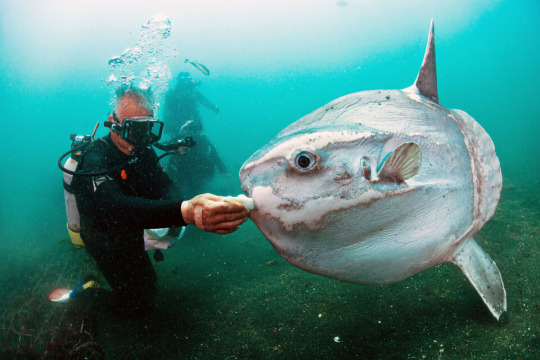
(Image: a SCUBA diver attempting to hand feed a small mola. End ID)
#wet beast wednesday#ocean sunfish#mola mola#name so nice you say it twice#countering sunfish slander#mola alexandrini#mola tecta#sharptail mola#Masturus lanceolatus#slender sunfish#Ranzania laevis#fish#fishblr#fishposting#marine biology#biology#zoology#ecology#animal facts#image described
171 notes
·
View notes
Text
Daily fish fact #458
Hoodwinker sunfish!
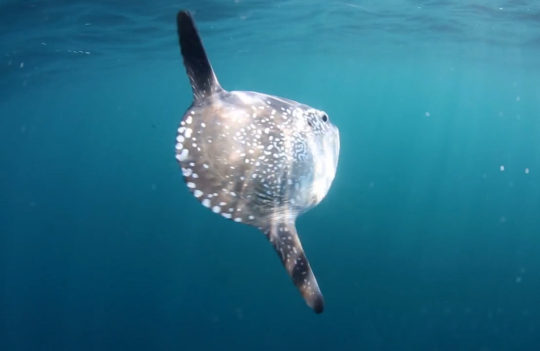
This species was only found very recently, as it was mistaken for other ocean sunfishes! Its scientific name, Mola tecta, references that, as "tecta" comes from the Latin word "tectus" which means hidden or disguised. However, it is distinguishable from other species as it is slimmer and lacks a lot of the "lumpiness" some of the other species have.
#mwahaha! another ocean sunfish fact! i am unstoppable!#fish#fishfact#fish facts#fishblr#marine biology#marine life#marine animals#sea creatures#sea animals#sea life#biology#zoology#hoodwinker sunfish#sunfish#mola tecta#oh and by ocean sunfish i literally mean sunfish that is found in the ocean! “ocean sunfish” of course means the mola mola#i wanted to distinguish between freshwater and saltwater sunfish because theyre completely different but i now see how that tag could be-#read wrong whoops
367 notes
·
View notes
Text
she

on my
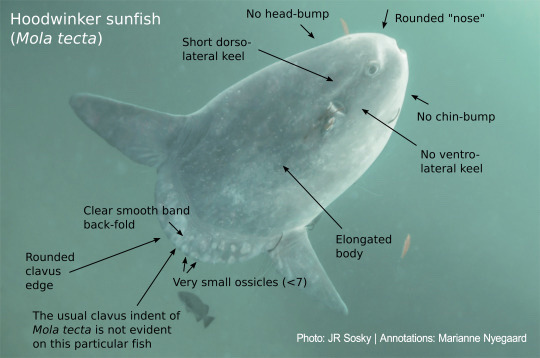
til i
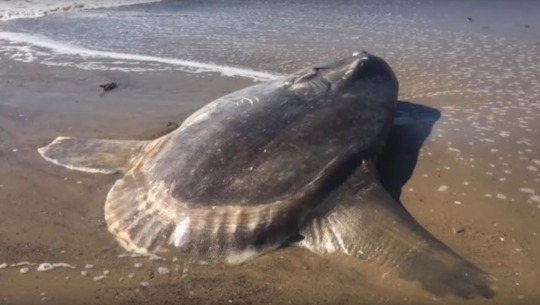
115 notes
·
View notes
Note
whatts ur fav fish
sunfish!!! specifically the mola tecta <3
10 notes
·
View notes
Note
Hello! Two questions- 1, Is it okay to use your art as a profile picture on social media such as Discord? (With credit in the bio of course) and 2, what do you think of other species of mola such as Ranzania laevis?
Thanks for reading! I hope you’re having a good holiday season :)
Yes, you're more than welcome to use my art with credit!
As for other mola species, I really like Mola tecta, their spots are really pretty. Mola alexandrini on the other hand, looks kinda spooky.
0 notes
Text
First Record of the Ocean Sunfish, Mola alexandrini (Ranzani 1839), (Tetraodontiformes: Molidae) from the Coastal Waters of Andhra Pradesh, India

Authored by: P Padmavathi
Abstract
Mola alexandrine, commonly known as bump-head sunfish has been reported for the first time from Andhra Pradesh coastal waters. A detailed morphological description of the specimen is provided, and the morphometric and meristic data are compared with those of the same species reported by earlier workers. Historical records of the family Molidae from Indian waters are summarized and discussed.
Keywords: First record; Mola alexandrine; Morphometrics and meristics; Ocean sunfish
Introduction
The ocean sunfishes belonging to the family Molidae are composed of three genera (Ranzania, Masturus and Mola) with five valid species viz., Ranzania laevis (Pennant 1776), Masturus lanceolatus (Lienard 1840), Mola mola (Linnaeus 1758), Mola tecta (Nyegaard et al. 2017) and Mola alexandrini (Ranzani 1839) [1-4]. Family Molidae is monophyletic among highly derived order Tetraodontiformes [5] and characterized by distinctly-shaped body by the lack of true caudal fin, which is replaced by a broad stiff lobe, a pseudo-caudal fin called clavus [6]. These fishes are known to be active swimmers and opportunistic foragers in the pelagic waters of both temperate and tropical oceans [7-9]. The occurrence of ocean sunfishes is rare from Indian coastal waters [10]. However, the presence of some molds has been reported in new areas [11] and previously known distribution ranges are being expanded [12]. These fishes occupy a unique position in marine food web [13,14]. The consumption of these oddly species has not been attracted the folk’s attention due to their rare occurrence and lack of information on their nutritional aspects. However, the meat of the ocean sunfishes is reported to be delicious in Taiwan and Japan [15].
The bump-head sunfish, Mola alexandrini (Ranzani 1839) is a large pelagic species which claimed a record of world’s heaviest teleost fish with a weight of 2,300 kg with 272 cm TL [16]. However, this fish may grow even larger [17]. Sawai et al. [16] found Mola alexandrini (Ranzani 1839) to be synonymous with Mola ramsayi (Giglioli 1883). The present study reports the first record of M. alexandrini from the coastal waters of Andhra Pradesh, India, and an attempt was made to compare the morphological, morphometric, and meristic characters among the known records of the species. The historical records of the family Molidae from the Indian coastal waters are provided and discussed.
Materials and Methods
One specimen of M. alexandrini was collected as by-catch from trawl catches of Kakinada fishing harbor (16° 58′ 30″ N, 82° 16′ 44″ E), East Godavari district, Andhra Pradesh, India (Figure 1). The fish was caught from commercial trawler operated at a depth range of 20-100m on 11th December 2018. The morphological characters were observed in fresh specimen. Morphometric and meristic details were recorded using the standard methods of Fraser-Brunner [6] and Whitley [18]. The species was identified based on the description given by Fraser-Brunner [6]; Sawai et al. [16]; Yosita et al. [17]; Nyegaard et al. [19]. Morphometric measurements were taken as straight-line distances (±1mm) using a 500 cm tape with 1mm gradation.
They included the total length (TL), a linear distance from the tip of the snout to the distal edge of the clavus; pre-clavus band length (PCBL), the straight distance from the tip of snout to the origin of clavus; total body depth (TBD), a linear length between dorsal fin and anal fin tips; body depth (BD), vertical distance between the dorsal and ventral margin of the body where the height is greatest; eye diameter (ED), the distance between the anterior and posterior edges of the orbit; pre-orbital length (POL), the distance between the tip of snout to the origin of eye orbit; pre-dorsal length (PDL), a straight distance from the tip of the snout to the anterior edge of dorsal fin; pre-pectoral length (PPCL), measured from the tip of snout to the anterior end of the pectoral fin; pre-anal length (PAL), a straight distance from the tip of the snout to the anterior end of the anal fin; height of dorsal fin (DFH), the vertical distance from the base to the tip of the dorsal fin; height of anal fin (AFH), the vertical distance from the base to the tip of the anal fin; and length of pectoral fin (PCFL), measured between its origin to the extreme tip. Meristic characteristics included the counts of fin rays in dorsal, pectoral, and anal fins, and clavus ossicles.
Results
Taxonomic position
• Phylum: Chordata
• Class: Actinopterygii
• Order: Tetraodontiformes Berg, 1940
• Family: Molidae Bonaparte, 1835
• Genus: Mola Koelreuter, 1766
• Species: M. alexandrini (Ranzani 1839).
Description
Body orbicular, deep and laterally compressed; skin thick and leathery; scales rectangular; mouth small and terminal; teeth on both jaws fused and beak-like; eyes small; pair of small nostrils in front of eyes; head bump extends from above the eyes to the base of dorsal fin; chin bump from beneath the lower jaw to anal fin base; gill openings small and oval; dorsal and anal fins opposite and triangle shaped; fins with soft rays and spineless; pelvic and caudal fins absent; caudal fin replaced by broad clavus with round margin; smooth band at the base of clavus between dorsal and anal fins; pectoral fin small rounded. Body gray to silvery white dorsally, dusky white ventrally, dorsal and clavus region with reddish brown tinge; fins bluish black, and many irregular paler spots over the body (Figures 2 & 3). The morphometric and meristic characters of the present specimen along with those of earlier works on M. alexandrini are shown in Table 1.
Discussion
The homogeneity in the morphological characters of Mola has created confusion in the species identification. However, the major distinguishing characters for the identification of Mola species are the presence or absence of head bump, chin bump and smooth band back-fold at the base of clavus; shape of the clavus margin; number of fin rays and ossicles in clavus; and the shape of the body scales [6,16,17,19-22]. The diagnostic characters of M. alexandrini observed in the present study such as the presence of head and chin bumps; smooth band at the base of clavus without a back-fold; rounded clavus; 12 clavus ossicles; scales rectangular on middle region of body and paler spots over the body are in conformity with those observed by the earlier workers [6,16,19].
The historical records of the family Molidae for over 65 years (1953-2018) from Indian coastal waters have been presented in Table 2. Based on the historical data, the distribution of the family Molidae in Indian waters is restricted to four species namely M. mola, M. lanceolatus, R. laveis, and M. alexandrini. Of these, M. mola [23] and M. lanceolatus [24] have been reported from coastal waters of Andhra Pradesh. M. alexandrini was reported in Indian waters with the rare occurrence of two records, one from Chennai, Tamil Nadu by Mohan et al. [21] and the other from Kochi, Kerala by Kishor et al. [20]. Hence, it is evident that the current reporting of M. alexandrini is the 3rd record from India and the first ever report from Andhra Pradesh.
In Indian coastal waters, the ocean sunfishes are considered as vagrant species, with only few sporadic sightings. Since 1990’s, however, there has been a considerable increase in the frequency of molids observed in Indian waters [25-30] (Table 2). The occurrence of M. alexandrini in the study area might be due to the fact that the species which are weak may get drifted to the coastal waters by strong currents or in course of chasing specific plankton/diatoms, as they are opportunistic foragers and selective feeders [3,5,13]. Moreover, in recent times there has been a massive development of fisheries and upgraded fishing vessels extended their trawling operations into deeper waters, catching more varieties of fishes in the study region [31-35]. The present report of the species from Andhra Pradesh coastal waters along central east coast of India would help in creating new awareness and scope for the proper documentation of data on this deficient species from the Indian waters [36-47].
N- Number of individuals; TL- Total length; TW- Total weight
To Know More About Oceanography & Fisheries Open Access Journal Please click on:
https://juniperpublishers.com/ofoaj/index.php
For more Open Access Journals in Juniper Publishers please click on:
https://juniperpublishers.com/index.php
0 notes
Text
An ASCII overview of the Molidae fish family:
Common sunfish
Mola mola
|\
Σ  ̄ ̄\
Σ C ° 3
Σ ____/
|/
Bumphead sunfish
Mola alexandrini
|\
Σ  ̄ ̄)
Σ C ° 3
Σ ___/
|/
Hoodwinker sunfish
Mola tecta
|\
Σ || ̄ ̄\
Σ= C ° 3
Σ ||____/
|/
Sharptail sunfish
Masturus lanceolatus
|\
Σ  ̄ ̄\
< C ° 3
Σ ____/
|/
Slender sunfish
Ranzania laevis
|\_______
( •o•
|/ ̄ ̄ ̄
#monterey bay aquarium#mola#molidae#mola mola#mola tecta#mola alexandrini#masturus lanceolatus#ranzania laevis#ocean sunfish#common sunfish#hoodwinker sunfish#bumphead sunfish#sharptail sunfish#slender sunfish#ascii me anything
10K notes
·
View notes
Text
This sunfish in our museum foyer is Mola tecta, and apparently this exact one was used to help identify and describe the species. This is the biggest known individual of the species.

Toilet door shown in the pic for scale. It big.
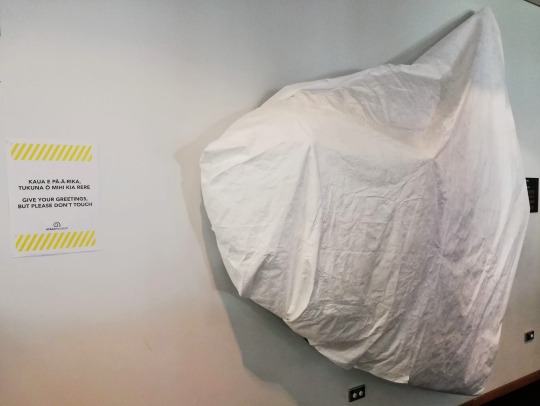
Whenever we go into Covid Level 2, they cover up the sunfish (with what looks like a fitted sheet) to stop people patting it and spreading germs, because everyone loves it. (I love it).
The sign is great too. I love it as an example of how translations between languages are so much more complicated than monolingual people tend to think.
English: Give your greetings but please don’t touch.
Māori (Kāi Tahu): Kaua e pā-ā-rika. Tukuna ō mihi kia rere.
Literal English translation of the Māori: Don’t hand-touch. Release your greetings to fly.
1 note
·
View note
Photo

A conservationist examines a beached hoodwinker sunfish at Coal Oil Point Reserve in Santa Barbara, California. It is the first time this species has been seen in the northern hemisphere in 130 years
Photograph: Thomas Turner/UC Santa Barbara/AP
(via The week in wildlife – in pictures | Environment | The Guardian)
This individual was first reported on iNaturalist.
#Hoodwinker Sunfish#Mola tecta#Mola#Molidae#Tetraodontiformes#Actinopterygii#Osteichthyes#fish#sunfish#beach#citizen science#California
57 notes
·
View notes
Text
Holy Mola Tecta!
Above is the link to a crazy-cool story on how this 7-foot, "Hoodwinker Sunfish," (aka Mola Tecta) was recently found, and identified as such, a whole hemisphere away from where it has ever been seen before! This Mola Tecta, or Hoodwinker Sunfish, took a while to be thoroughly examined and accurately identified. Once it was identified as such, an amazing discovery was made! The discovery of this subspecies was made a couple of years ago, in the ocean waters around Australia! A UCSB intern, who took a morning walk on the beach, reported back immediately! Also, it's great how the right people came together on iNaturalist, an application that helped UCSB biologists (University of California, Santa Barbara) connect with experts on this particular fish... who were located in New Zealand and Australia! Using the application they were able to correctly identify the subspecies! The Mola Mola is a more common sunfish around there, so that was the first suspect. They had to be sure, and all involved, were hoodwinked by this Hoodwinker Sunfish from the southern hemisphere. This was a fish who made a very long journey to a gorgeous resting place, if I do say so myself. Santa Barbara's coastal areas are gorgeous and, if I was a fish, I would go there to live out my final hours or days as well!
P.S. Great job to all involved with this find, ID, and to Fox News for writing up an article about this story. I am glad to know that there are still good things in the news these days, sometimes.
P.P.S. Thanks for reading my geeked out brain's interpretation of what happened. I tried to have some fun with it while staying true to facts. It is late so if there are typos, I'm sorry..but I was too excited not to share!
#goscience
#ucsb#ucsb marine biology#mola tecta#giant sunfish#hoodwinker sunfish#hoodwinker#fish#sunfish#giant fish#monster sunfish#marine biology#california#cool fish#mola tecta sunfish
2 notes
·
View notes
Photo

RISE THE SUNFISH: RESEARCHERS UNCOVER NEW SPECIES OF GIGANTIC BONYFISH
Probably you heard about the new species of sunfish discovered by scientists in New Zealand! We are excited, because is the first addition to the Mola genus in 125 years
Previously undescribed, the new especies of sunfish it's called the Hoodwinker Sunfish (Mola tecta). Marianne Nyegaard, an australian researcher made the discovery while researching the population genetics of ocean sunfish off the coast of Bali in Indonesia. She and her team spent four years searching for the fish, after genetic sequencing of 150 specimens in her research turned up with a new different species with remarkable body features.
The species name tecta is derived from the Latin tectus (disguised, hidden), as this species evaded discovery for nearly three centuries, despite the keen interest among early sunfish taxonomists and the continued attention these curious fish receive. While the English name, ‘Hoodwinker’, pertains to the figurative meaning ‘trickster, deceiving by disguise’, c. 1600. According to Nyergaard the Hoodwinker sunfish is thought to be widely distributed in all the world’s oceans except for the polar seas, however may be relatively uncommon in some areas, for example around Australia and New Zealand.
The taxonomy of ocean sunfishes (Family Molidae) has a complicated history, partially because they are so difficult to preserve and study, even for museums. If you don’t believe me, please look at this preserved common ocean sunfish (cf. Mola mola) at the National History Museum in Santiago de Chile.

Imagen: César Villarroel
Reference (Open Access): Nyegaard et al., 2017Hiding in broad daylight: molecular and morphological data reveal a new ocean sunfish species (Tetraodontiformes: Molidae) that has eluded recognition. Zoological Journal of the Linnean Society.
#chiquillos del museo porfa perdonenme#molidae#tetraodontidae#animals#biology#marine biology#new species#tenia que hablar de esto!!!#ocean sunfish#mola mola#mola tecta#Hoodwinker sunfish#sunfish#science#sciblr#scienceblr
507 notes
·
View notes
Link

A new species of enormous ocean sunfish was discovered after an intensive search, making it the first species of this type of fish to be identified in 130 years.
Despite being the largest bony fish in the world and weighing more than two tons, sunfish are quite elusive, which made the four-year search difficult.
A team of researchers led by Marianne Nyegaard, a PhD student at Murdoch University in Australia, analyzed more than 150 sunfish DNA samples and recognized four distinct species—but only three of the species had been previously identified.
The research team decided to call the species the hoodwinker sunfish, Mola tecta, which comes from the Latin word tectus, meaning hidden.It wasn’t until a year after this breakthrough that Nyegaard was able to see a hoodwinker sunfish up close. In 2014, she got a tip from a New Zealand fishery that four sunfish had washed up on a beach in Christchurch, and she flew down to see the evidence for herself.
314 notes
·
View notes
Link
A new species of Sunfish, Mola tecta, has just been described!
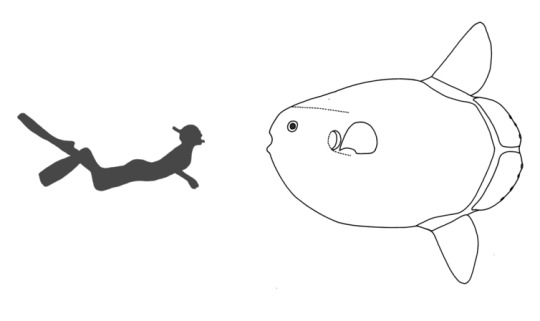
Illustration by Michelle Freeborn, Wellington Museum Te Papa Tongarewa.
53 notes
·
View notes
Text
ocean sunfish... sir... i care you
3 notes
·
View notes